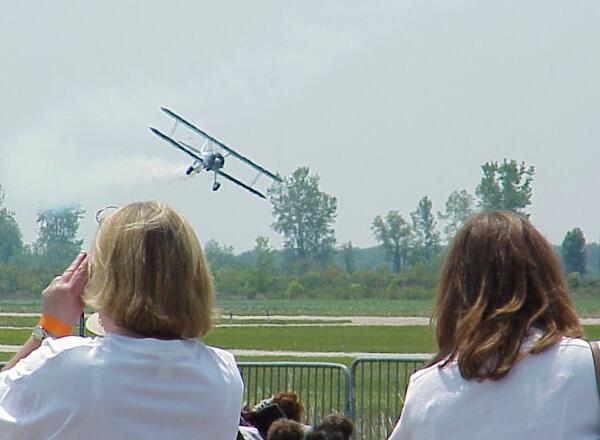
Spectators watch Air Show at James Clements Airport in Bay City. (MyBayCity File Photo by Steve Kent) SMALL AIRPORT CRISIS: Hub Consolidation Threatens Passenger Convenience
May 22, 2013
Leave a Comment
|
||||||||||
| Printer Friendly Story View |
Small airports and small airplanes may be things of the past, according to a new report from Massachusetts Institute of Technology (MIT).
MBS, Flint Bishop, Lansing and others in the mid-Michigan region have experienced severe drops in numbers of flights and passengers in the past six years, MIT said.
The "capacity discipline" movement has evolved in response to a new profit-driven management focus, as airlines cut unprofitable and redundant flying and minimized the number of empty seats on each departing plane," states the report.
"Many of these cuts came at the expense of small airports, as most network carriers do not possess aircraft that are correctly sized to serve these markets."
It is possible that as the network carriers continue to consolidate -- as Southwest joins this group once it introduces international service following the complete integration of its AirTran assets -- that the four largest remaining U.S. carriers will once again compete on the relative sizes of their networks.
This is perhaps the best possible outcome for small community airports, since airlines will be racing to add new spokes to their hubs in order to offer their customers the most connectivity possible.
However, it is more likely that profitability-based metrics will continue to rule the day through the 2010s. In this scenario, small community airports may continue to struggle to receive network carrier service. Some carriers will signal their exits out of small communities by attempting to divest their regional jets. Other low-cost or ultra-regional carriers may move in to replace the network carrier service, but often at the expense of the small community's connectivity to the global air transportation network.
As the earlier taxonomy of small community air service analysis suggests, smaller airports in multi-airport regions may be particularly at risk, as passengers will likely choose to drive to a nearby larger airport to save on airfare or take advantage of more connecting options.
What will be the future of small community air service if the current trends continue for the rest of the decade? Most likely, smaller airports will continue to go quiet, but not dark.
Entrenched network carriers will likely not choose to exit many small markets en masse at the risk of losing that revenue to a nimbler competitor, although a regional jet pilot shortage as a result of current legislation would likely hasten the exit of network carriers from some small communities.
Flight volumes at smaller airports will continue to stagnate, although the ULCCs could well take over operations at the airports that do indeed lose network carrier service. Levels of air service will likely continue to fall in many small markets, but passenger accessibility to air service across an entire multi-airport region may not be as adversely affected.
Some will argue that the reduction of service at small community airports is a welcome one -- passengers in small communities are already showing their preference for larger airports, and consolidation of service at large hubs will create a leaner and more efficient air transportation network that is more likely to be profitable (yet also more likely to be congested).
Others will argue that the reduction in service at smaller airports reflects a growing national shift of attention away from smaller communities and towards larger urban centers.
The important debate about which communities 'deserve' commercial air service will almost certainly intensify over the next several years, and its arguments will be made in airline boardrooms, in the halls of Congress, and over the check-in counters at smaller airports. The lessons and conclusions from this debate will continue to inform national aviation policy, particularly concerning the Essential Air Service program and the small communities it decides to subsidize.
###
| Printer Friendly Story View |
|
|

Dave Rogers |
|
|
|
Printer-Friendly Story View
0200 Nd: 04-15-2024 d 4 cpr 0
12/31/2020 P3v3-0200-Ad.cfm
SPONSORED LINKS
12/31/2020 drop ads P3v3-0200-Ad.cfm


